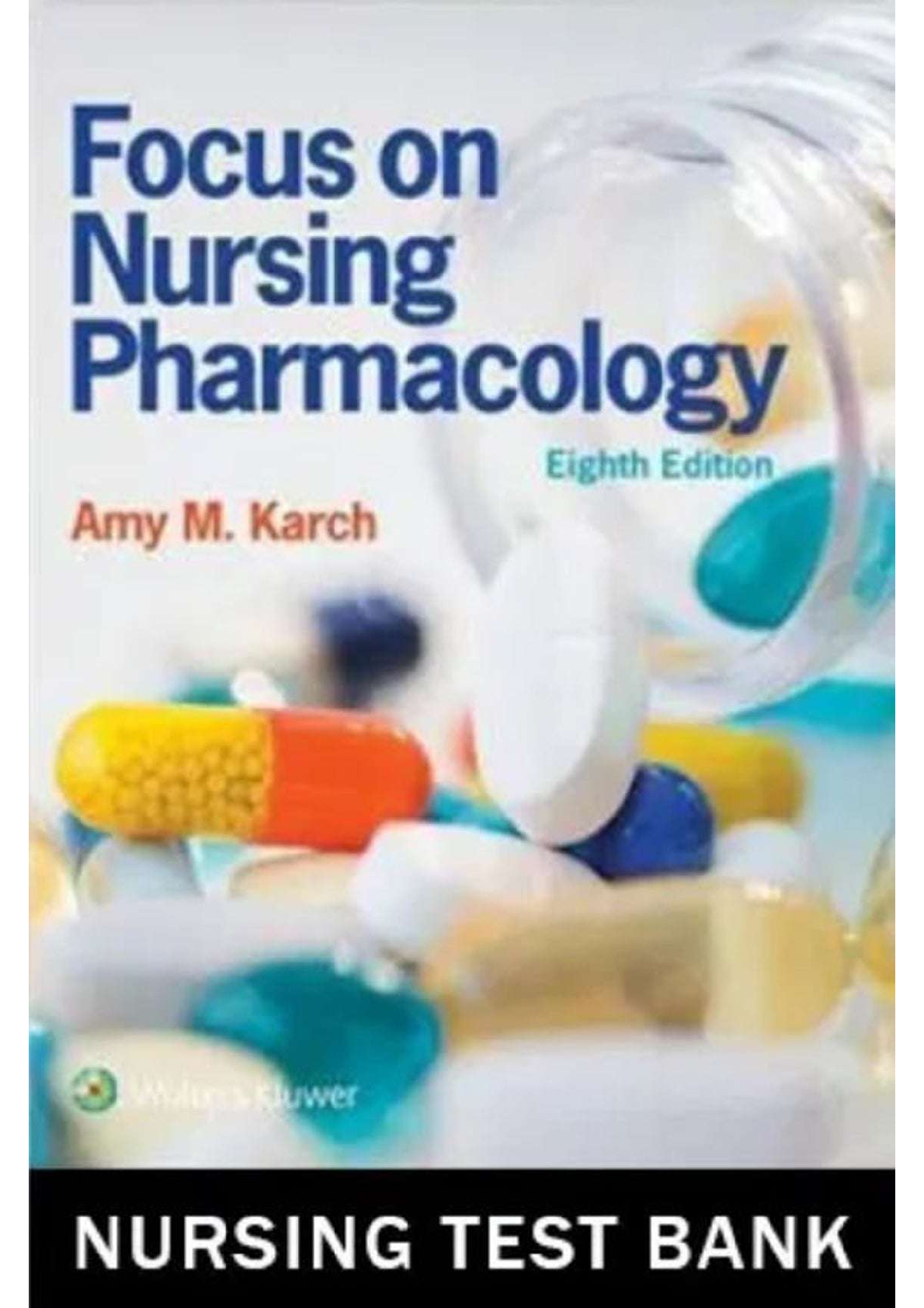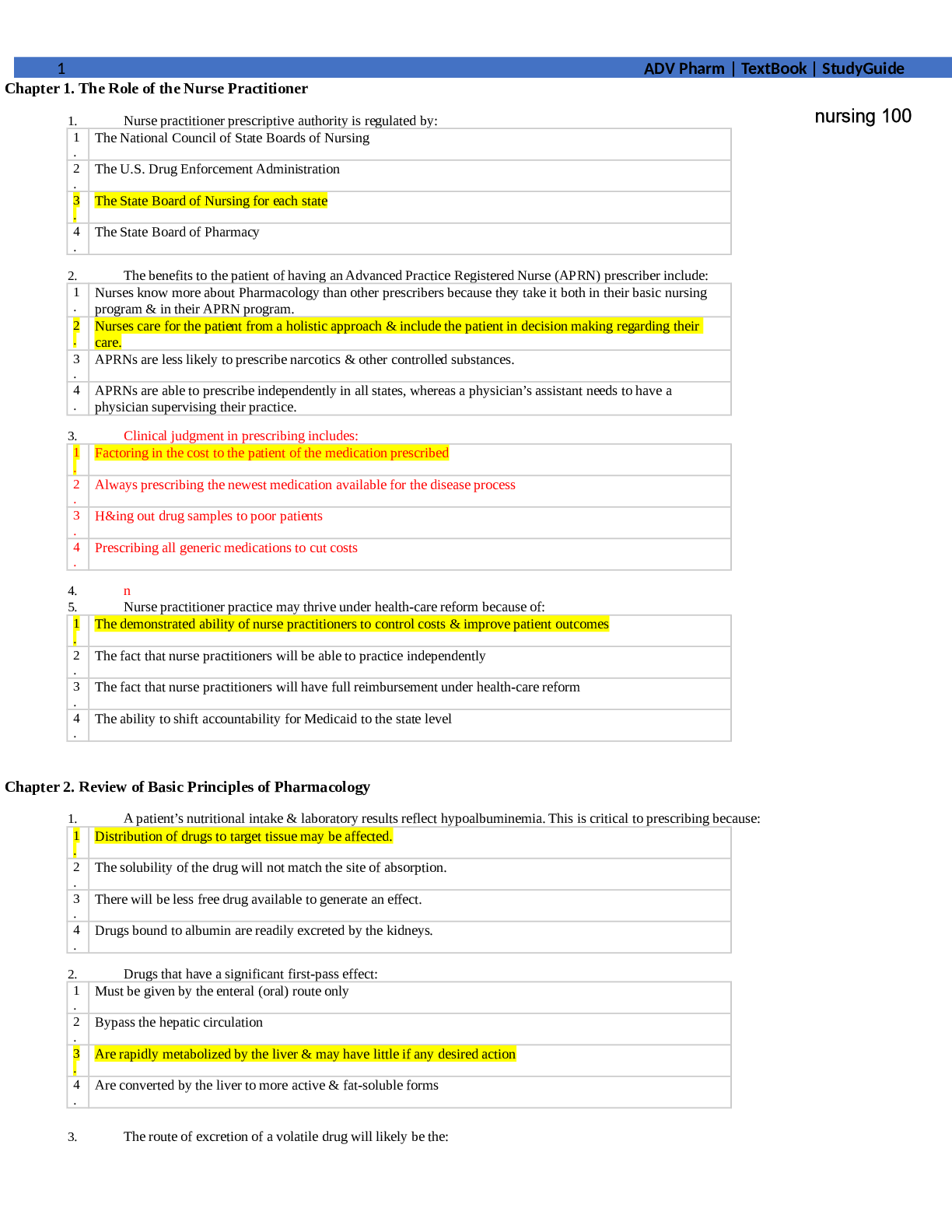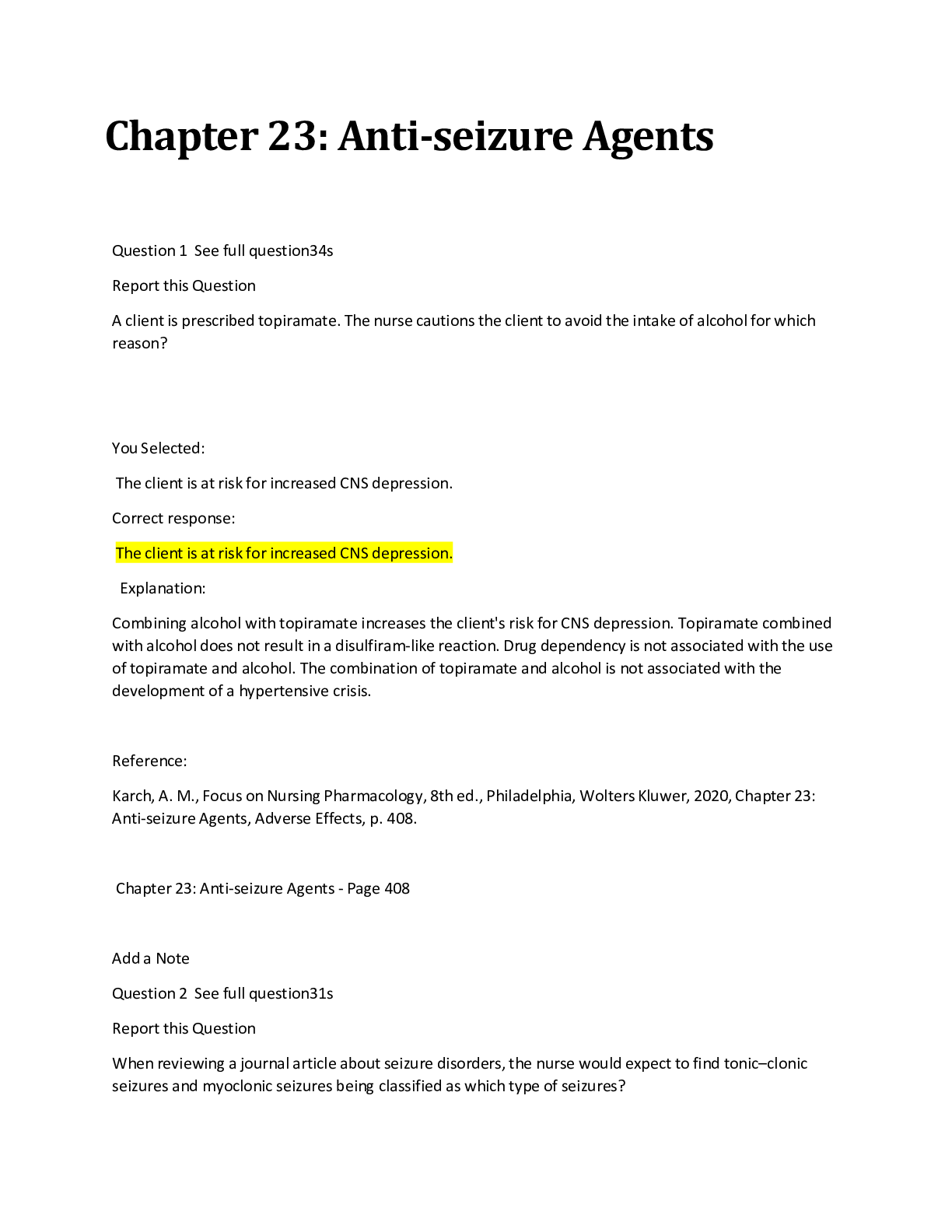*NURSING > EXAM > Chapter 9: Antibiotics | Karch, A. M., Focus on Nursing Pharmacology, 8th ed. | with rationales | G (All)
Chapter 9: Antibiotics | Karch, A. M., Focus on Nursing Pharmacology, 8th ed. | with rationales | GRADED A.
Document Content and Description Below
Chapter 9: Antibiotics Question 1 See full question1m 15s Report this Question Drugs that destroy bacteria are known as which type of drug? You Selected: bacteriocidal Correct response:... bacteriocidal Explanation: Drugs that destroy bacteria are known as bactericidal. Drugs that slow or retard the multiplication of bacteria are known as bacteriostatic. Bacteriostationary keeps the bacteria in place, and bacteriophage uses enzymatic substances to destroy the bacteria. Reference: Karch, A. M., Focus on Nursing Pharmacology, 8th ed., Philadelphia, Wolters Kluwer, 2020, Chapter 9: Antibiotics, SUMMARY, p. 138. Chapter 9: Antibiotics - Page 138 Add a Note Question 2 See full question1m 51s Report this Question The ability of bacteria to produce substances that inactivate or destroy the antibiotic is known as which of the following? You Selected: Bacterial resistance Correct response: Bacterial resistance Explanation: The ability of bacteria to produce substances that inactivate or destroy the antibiotic is known as bacterial resistance. Reference: Karch, A. M., Focus on Nursing Pharmacology, 8th ed., Philadelphia, Wolters Kluwer, 2020, Chapter 9: Antibiotics, Bacteria and Resistance to Antibiotics, p. 102. Chapter 9: Antibiotics - Page 102 Add a Note Question 3 See full question51s Report this Question Which statement is true in regards to the oral administration of tetracyclines? You Selected: Tetracyclines should be administered with a full glass of water. Correct response: Tetracyclines should be administered with a full glass of water. Explanation: Tetracyclines should always be administered with a full glass of water and on an empty stomach (except minocycline and tigecycline may be taken with food). Reference: Karch, A. M., Focus on Nursing Pharmacology, 8th ed., Philadelphia, Wolters Kluwer, 2020, Chapter 9: Antibiotics, Patient Teaching for G.S., p. 125. Chapter 9: Antibiotics - Page 125 Add a Note Question 4 See full question1m 46s Report this Question A client has been prescribed 2 tablets of 150 mg isoniazid every day. The available drug is in the form of a 100-mg tablet. To meet the recommended dose, the nurse will administer tablets each time. You Selected: 3 Correct response: 3 Explanation: Required dosage is 2 tablets of 150 mg, meaning that the client needs to take in 300 mg of isoniazid daily. Available tablet contains 100 mg of the drug. Therefore, 3 tablets (100*3) of isoniazid need to be administered daily. Reference: Karch, A. M., Focus on Nursing Pharmacology, 8th ed., Philadelphia, Wolters Kluwer, 2020, Chapter 9: Antibiotics, Table 9.8 Drugs in Focus: Antimycobacterials, p. 127. Chapter 9: Antibiotics - Page 127 Add a Note Question 5 See full question35s Report this Question What organ system is responsible for the excretion of cefotaxime sodium from the body? You Selected: renal Correct response: renal Explanation: Cefotaxime sodium, like all cephalosporins, is excreted by the kidneys. Cefotaxime is not excreted by the lungs, liver, or GI tract. Reference: Karch, A. M., Focus on Nursing Pharmacology, 8th ed., Philadelphia, Wolters Kluwer, 2020, Chapter 9: Antibiotics, Table 9.3 Drugs in Focus: Cephalosporins, p. 109. Chapter 9: Antibiotics - Page 109 Add a Note Question 6 See full question30s Report this Question A client is being treated for a urinary tract infection with trimethoprim-sulfamethoxazole. What assessment should the nurse make prior to the administration of the medication? You Selected: assessing for renal insufficiency Correct response: assessing for renal insufficiency Explanation: Both tetracyclines and sulfonamides are contraindicated in clients with renal failure because of the risk of increased injury since they are excreted via the kidneys. These medications are not contraindicated in clients with asthma, hypertension, or diabetes mellitus unless there is a preexisting renal issue. Reference: Karch, A. M., Focus on Nursing Pharmacology, 8th ed., Philadelphia, Wolters Kluwer, 2020, Chapter 9: Antibiotics, Nursing Considerations for Patients Receiving Sulfonamides, p. 121. Chapter 9: Antibiotics - Page 121 Add a Note Question 7 See full question20s Report this Question What is the rationale for not administering tetracycline to children under the age of 8 years? You Selected: It will interfere with enamel development. Correct response: It will interfere with enamel development. Explanation: Tetracyclines should not be used in children younger than 8 years because of their effects on teeth and bones. In teeth, the drugs interfere with enamel development. Without existing contraindications, tetracycline can be used in children to treat infections without increasing the risk of heart failure. The administration of tetracycline will not increase the risk of future infections in children. Reference: Karch, A. M., Focus on Nursing Pharmacology, 8th ed., Philadelphia, Wolters Kluwer, 2020, Chapter 9: Antibiotics, Box 9.2, p. 101. Chapter 9: Antibiotics - Page 101 Add a Note Question 8 See full question40s Report this Question A nurse is caring for a patient who has a serious infection. The patient is being treated with combination therapy of a cefazolin and an aminoglycoside. The nurse will be sure to monitor which of the following? You Selected: Serum BUN and creatinine levels Correct response: Serum BUN and creatinine levels Explanation: Patients receiving combination therapy of a cefazolin and an aminoglycoside will need to be monitored for nephrotoxicity and therefore would need serum BUN and creatinine levels done. Serum sodium and potassium levels as well as aspartate aminotransferase should be monitored when receiving sodium penicillin G. PT and PTT should be monitored when a patient is receiving aztreonam, a monobactam antibiotic. Reference: Karch, A. M., Focus on Nursing Pharmacology, 8th ed., Philadelphia, Wolters Kluwer, 2020, Chapter 9: Antibiotics, Cephalosporins, p. 111. Chapter 9: Antibiotics - Page 111 Add a Note Question 9 See full question34s Report this Question A 25-year-old woman is being treated with penicillin G as prophylaxis to prevent bacterial endocarditis prior to a dental procedure. The nurse should question the client concerning her the use of: You Selected: oral contraceptives. Correct response: oral contraceptives. Explanation: The nurse should document the method of birth control used by a woman of childbearing age because antibiotics, such as penicillin G, can counteract the effects of an oral contraceptive. The client should be advised to use a backup method of birth control for the duration of the therapy. Excess fats in the diet, alcohol, and nicotine should be avoided, but pose no special risk when used along with penicillin G. Reference: Karch, A. M., Focus on Nursing Pharmacology, 8th ed., Philadelphia, Wolters Kluwer, 2020, Chapter 9: Antibiotics, Penicillins and Penicillinase- Resistant Antibiotics, pp. 115-116. Chapter 9: Antibiotics - Page 115-116 Add a Note Question 10 See full question13s Report this Question A client is taking rifampin (Rifadin) for active TB. The nurse should stress that what may be caused by the use of this drug? You Selected: body fluids such as urine, saliva, tears, and sputum may become discolored. Correct response: body fluids such as urine, saliva, tears, and sputum may become discolored. Explanation: Rifampin can discolor body fluids red-orange. The client should be informed that this is an expected adverse effect and is harmless. However, wearers of soft contact lenses should be cautioned that the lenses may be permanently discolored and that hard contacts or regular glasses should be used during the therapy. Although rifampin is often well tolerated, it may cause GI disturbances such as nausea and vomiting, anorexia, flatulence, cramps, and diarrhea. Cardiac arrhythmias, seizures, and facial flushing are not typically associated with the use of this drug. Reference: Karch, A. M., Focus on Nursing Pharmacology, 8th ed., Philadelphia, Wolters Kluwer, 2020, Chapter 9: Antibiotics, Adverse Effects, p. 128. Chapter 9: Antibiotics - Page 128 Add a Note Question 11 See full question3m 48s Report this Question What is an advantage of daptomycin over other antibiotic therapy? You Selected: Daptomycin has less antibiotic resistance than other drugs used to treat against Gram-positive bacteria. Correct response: Daptomycin has less antibiotic resistance than other drugs used to treat against Gram-positive bacteria. Explanation: Daptomycin is the only drug in a new class of antibiotics called cyclic lipopeptides. This class of antibiotics has a substantially different mechanism of action than other antibiotic drugs. Another benefit of daptomycin is its ability to retain potency against antibiotic-resistant Gram-positive bacteria. It works by binding to the bacterial membrane and interfering with the integrity of the cell wall. This disruption causes a rapid depolarization of the membrane potential that leads to inhibition of protein, DNA, and RNA synthesis and, eventually, bacterial cell death. Daptomycin also has a postantibiotic effect that lasts approximately 6 hours. Daptomycin is a once-daily IV medication. Reference: Karch, A. M., Focus on Nursing Pharmacology, 8th ed., Philadelphia, Wolters Kluwer, 2020, Chapter 9: Antibiotics, New Antibiotics and Adjuncts, p. 138. Chapter 9: Antibiotics - Page 138 Add a Note Question 12 See full question3m 41s Report this Question A client has been prescribed INH for the treatment of tuberculosis. The nurse teaches the client about dietary restrictions while taking this medication. What is the most important instruction? You Selected: "Do not drink beer or red wine while taking this medication because a serious adverse reaction can occur." Correct response: "Do not drink beer or red wine while taking this medication because a serious adverse reaction can occur." Explanation: Because INH has some monoamine oxidase inhibitor activity, interactions may occur with tyramine- containing foods. INH may also interact with foods containing histamine. Clients should refrain from excessive intake of foods rich in tyramine, which include cheese and dairy products, beef or chicken liver, beer and ale, red wine, avocados, bananas, figs, raisins, caffeine, and chocolates. Because most people consume these food items, the diet is difficult to maintain. Reference: Karch, A. M., Focus on Nursing Pharmacology, 8th ed., Philadelphia, Wolters Kluwer, 2020, Chapter 9: Antibiotics, Therapeutic Actions and Indications, p. 135. Chapter 9: Antibiotics - Page 135 Add a Note Question 13 See full question21m 56s Report this Question A youngster has just returned home from the family's tropical vacation and is now reporting worsening tenderness in the right ear. When the child is diagnosed with otitis externa, what causative factor of this infection should the nurse focus upon? You Selected: frequent swimming and water sports while the child was on vacation Correct response: frequent swimming and water sports while the child was on vacation Explanation: People whose ears are frequently exposed to moisture are more prone to the development of otitis externa. Swimming is a more likely cause of infection than pressure changes, foodborne pathogens, or impaired immunity. Reference: Karch, A. M., Focus on Nursing Pharmacology, 8th ed., Philadelphia, Wolters Kluwer, 2020, Chapter 9: Antibiotics, Table 9.4 Drugs in Focus: Fluoroquinolones, p. 113. Chapter 9: Antibiotics - Page 113 Add a Note Question 14 See full question43s Report this Question A client has been on an antibiotic for two weeks for treatment of an infection. The client asks the nurse why a superinfection has been caused by this medication. What is the nurse's best response? You Selected: "Antibiotics can disrupt the normal bacteria in your body, causing another infection to occur." Correct response: "Antibiotics can disrupt the normal bacteria in your body, causing another infection to occur." Explanation: Superinfections are caused when the antibiotic destroys the normal flora within the body and a secondary infection occurs. The infection is caused by a different bacterial or fungal infection. Reference: Karch, A. M., Focus on Nursing Pharmacology, 8th ed., Philadelphia, Wolters Kluwer, 2020, Chapter 9: Antibiotics, Box 9.2 Focus on Drug Therapy across the Lifespan, p. 101. Chapter 9: Antibiotics - Page 101 Add a Note Question 15 See full question31s Report this Question A young lifeguard has been prescribed moxifloxacin (Avelox). The nurse understands that the focus on education would be which adverse reaction? You Selected: Photosensitivity Correct response: Photosensitivity Explanation: The lifeguard will be in the sun, and he is at risk for an exaggerated skin reaction. Weakness, fatigue and muscle cramping are not know adverse reactions to this medication, therefore with the client's job, photosensitivity is the highest priority. Reference: Karch, A. M., Focus on Nursing Pharmacology, 8th ed., Philadelphia, Wolters Kluwer, 2020, Chapter 9: Antibiotics, Adverse Effects, p. 113. Chapter 9: Antibiotics - Page 113 Add a Note Question 16 See full question39s Report this Question The nurse knows that pseudomembranous colitis is a superinfection of fluoroquinolones, especially when they are administered in high doses, because these medications have what effect in the body? You Selected: They disrupt the normal flora of the body. Correct response: They disrupt the normal flora of the body. Explanation: Pseudomembranous colitis is a superinfection that occurs when the antibiotic disrupts the normal flora, causing a secondary infection or superinfection. Reference: Karch, A. M., Focus on Nursing Pharmacology, 8th ed., Philadelphia, Wolters Kluwer, 2020, Chapter 9: Antibiotics, Adverse Effects, p. 104. Chapter 9: Antibiotics - Page 104 Add a Note Question 17 See full question9s Report this Question The nurse understands that which is the highest priority when teaching about antitubercular medications? You Selected: Taking medications as prescribed Correct response: Taking medications as prescribed Explanation: For medications to be effective, it is most important that the nurse reinforce to the client that medications should be taken as prescribed and there should be no missed doses. Eating a well balanced diet, keeping hydrated and monitoring sputum are not medication priorities. Reference: Karch, A. M., Focus on Nursing Pharmacology, 8th ed., Philadelphia, Wolters Kluwer, 2020, Chapter 9: Antibiotics, Antituberculosis Drugs, p. 127. Chapter 9: Antibiotics - Page 127 Add a Note Question 18 See full question1m 37s Report this Question A pregnant woman calls the clinic and asks if it is suitable to use ofloxacin otic drops that she used prior to pregnancy for a current ear infection. What would be an appropriate response from the nurse? You Selected: "The effects of ofloxacin in pregnancy are not known, so the drug should not be used while pregnant." Correct response: "The effects of ofloxacin in pregnancy are not known, so the drug should not be used while pregnant." Explanation: The otic drugs are used with caution during pregnancy and lactation. The pregnancy category of most of these drugs is unknown when they are used as otic drugs for this reason, ofloxacin is an otic drug that is contraindicated during pregnancy. Using left-over medication from one illness to the next is not advised. Many otic drugs are not contraindicated during pregnancy. Not all medications that are okay for children are suitable to use during pregnancy. Reference: Karch, A. M., Focus on Nursing Pharmacology, 8th ed., Philadelphia, Wolters Kluwer, 2020, Chapter 9: Antibiotics, Pharmacokinetics, p. 112. Chapter 9: Antibiotics - Page 112 Add a Note Question 19 See full question50s Report this Question Oral ampicillin has been ordered for a client whose urinary tract infection will be treated in a home setting. When providing antibiotic teaching to this client, the nurse should stress which instruction? You Selected: Drink a full glass of water when taking a dose of the drug. Correct response: Drink a full glass of water when taking a dose of the drug. Explanation: Clients taking penicillins should take oral doses with a full glass of water to ensure sufficient hydration while taking the medication. The drugs should otherwise be taken on an empty stomach. Tapering is unnecessary, and it is not advised to take the drug with diphenhydramine in an effort to reduce the allergy risk. Reference: Karch, A. M., Focus on Nursing Pharmacology, 8th ed., Philadelphia, Wolters Kluwer, 2020, Chapter 9: Antibiotics, Therapeutic Actions and Indications, p. 106. Chapter 9: Antibiotics - Page 106 Add a Note Question 20 See full question1m 11s Report this Question A client has been prescribed 4 g of sulfamethoxazole/trimethoprim tablets per day. The available drug is in the form of 500 mg. The nurse would administer how many tablets each day? You Selected: 8 Correct response: 8 Explanation: The required dosage is 4 g per day. Available drug is in the form of 500 mg. Therefore, eight (4000 mg/500 mg) tablets have to be administered every day. Question 1 See full question10s Report this Question A client is to receive rifampin. Which would be most important for the nurse to include in the teaching plan for this client? You Selected: "Your urine or sweat may become orange in color." Correct response: "Your urine or sweat may become orange in color." Explanation: This drug causes body fluids to turn orange. The client needs to be informed of this to avoid being frightened when it occurs. Any drug can cause a hypersensitivity reaction. Although this information is important, it is not the priority. GI adverse effects are common. Although this instruction would be important, it would not be the priority. Headache and dizziness are common CNS effects of the drug that do not need to be reported. Reference: Karch, A. M., Focus on Nursing Pharmacology, 8th ed., Philadelphia, Wolters Kluwer, 2020, Chapter 9: Antibiotics, Adverse Effects, p. 128. Chapter 9: Antibiotics - Page 128 Add a Note Question 2 See full question13s Report this Question After teaching a group of nursing students about the different classes of drugs, the instructor determines that the teaching was successful when the students identify drugs that slow or retard the multiplication of bacteria as which types of medication? You Selected: bacteriostatic Correct response: bacteriostatic Explanation: Drugs that slow or retard the multiplication of bacteria are known as bacteriostatic. Drugs that destroy the bacteria are referred to as bactericidal. Bacteriostationary keeps the bacteria in place, and bacteriophage uses enzymatic substances to destroy the bacteria. Reference: Karch, A. M., Focus on Nursing Pharmacology, 8th ed., Philadelphia, Wolters Kluwer, 2020, Chapter 9: Antibiotics, SUMMARY, p. 138. Chapter 9: Antibiotics - Page 138 Add a Note Question 3 See full question33s Report this Question A nursing instructor is preparing a teaching plan for a nursing pharmacology class on the action of fluoroquinolones. Which action would the instructor most likely include? You Selected: interfering with DNA synthesis in the bacterial cell Correct response: interfering with DNA synthesis in the bacterial cell Explanation: The fluoroquinolones exert their bactericidal effect by interfering with the synthesis of bacterial DNA by not allowing the cell to reproduce. The tetracyclines are bacteriostatic and exert their effect by inhibiting bacterial protein synthesis. Penicillins act to disrupt the bacterial cell wall. The aminoglycosides exert their bactericidal effect by blocking the ribosome from reading the mRNA, a step in protein synthesis necessary for bacterial multiplication. Reference: Karch, A. M., Focus on Nursing Pharmacology, 8th ed., Philadelphia, Wolters Kluwer, 2020, Chapter 9: Antibiotics, Fluoroquinolones, p. 112. Chapter 9: Antibiotics - Page 112 Add a Note Question 4 See full question1m 14s Report this Question A 72-year-old patient with TB is undergoing standard treatment in a health care facility. Which of the following nursing interventions should the nurse perform during ongoing assessment of the treatment? You Selected: Monitor for appearance of adverse reactions. Correct response: Monitor for appearance of adverse reactions. Explanation: The nurse should monitor for the appearance of adverse reactions in the patient during ongoing assessment of the treatment. The nurse should monitor vital signs of the patient every four hours and not every 24 hours when the patient is hospitalized. The nurse should assess the patient's history of contacts as part of the pre-administration assessment and not as part of the ongoing assessment. DOT can only be used by the nurse to administer antitubercular drugs when the patient is at home, at his place of employment, or in school. DOT is not used when the patient is hospitalized. Reference: Karch, A. M., Focus on Nursing Pharmacology, 8th ed., Philadelphia, Wolters Kluwer, 2020, Chapter 9: Antibiotics, Adverse Effects, p. 128. Chapter 9: Antibiotics - Page 128 Add a Note Question 5 See full question42s Report this Question A 30-year-old woman who is in the first trimester of pregnancy has presented to her primary care provider with a 4-day history of a reddened, itchy left eye that is crusted with purulent exudate. The clinician suspects a bacterial, rather than viral, etiology. How will the client's pregnancy affect the potential use of ciprofloxacin to treat her conjunctivitis? You Selected: The use of ciprofloxacin is contraindicated in pregnancy. Correct response: The use of ciprofloxacin is contraindicated in pregnancy. Explanation: Ciprofloxacin is contraindicated in clients who are pregnant or lactating. Alternative routes and dosages do not mitigate the risks during pregnancy. Reference: Karch, A. M., Focus on Nursing Pharmacology, 8th ed., Philadelphia, Wolters Kluwer, 2020, Chapter 9: Antibiotics, Contraindications and Cautions, p. 113. Chapter 9: Antibiotics - Page 113 Add a Note Question 6 See full question38s Report this Question Michael, 25 years old, has had mitral valve regurgitation since age four, after having rheumatic fever. Michael is planning to go to his dentist to have his teeth cleaned. Because of Michael's history he will need to take antibiotics in conjunction with this procedure to prevent bacteremia. Which class of antibiotics will Michael most likely receive if he has no allergies? You Selected: Penicillin Correct response: Penicillin Explanation: Penicillin G may also be used as prophylaxis in special patient populations to prevent bacterial endocarditis prior to procedures likely to produce temporary bacteremia, such as dental procedures. These patients include those with prosthetic heart valves, mitral valve prolapse, most congenital heart diseases, and acquired valvular heart disease. It may also be used as prophylaxis in patients with recurrent rheumatic fever or rheumatic heart disease. Reference: Karch, A. M., Focus on Nursing Pharmacology, 8th ed., Philadelphia, Wolters Kluwer, 2020, Chapter 9: Antibiotics, Penicillins and Penicillinase- Resistant Antibiotics, p. 115. Chapter 9: Antibiotics - Page 115 Add a Note Question 7 See full question1m 11s Report this Question A nurse is speaking to a 62-year-old female client who has been started on sulfisoxazole, a sulfonamide antibiotic. The nurse should teach this client to contact the health care provider if the client experiences what adverse effect associated with the drug? You Selected: skin rash or itching Correct response: skin rash or itching Explanation: Clients taking sulfonamides should be instructed to contact the prescriber if they experience skin rash or itching. These symptoms may indicate a sulfonamide-induced allergic reaction and the need to change or stop the drug. Reference: Karch, A. M., Focus on Nursing Pharmacology, 8th ed., Philadelphia, Wolters Kluwer, 2020, Chapter 9: Antibiotics, Bacteria and Antibiotics, p. 99. Chapter 9: Antibiotics - Page 99 Add a Note Question 8 See full question35s Report this Question A female client’s medical history includes type 2 diabetes, CVA, dysphasia, and chronic renal failure. She develops an infectious process. The health care provider orders erythromycin. Based on the client’s medical history, why is erythromycin the drug of choice? You Selected: It is metabolized in the liver. Correct response: It is metabolized in the liver. Explanation: Erythromycin is generally considered safe. Because it is metabolized in the liver and excreted in bile, it may be an alternative in clients with impaired renal function. Reference: Karch, A. M., Focus on Nursing Pharmacology, 8th ed., Philadelphia, Wolters Kluwer, 2020, Chapter 9: Antibiotics, Pharmacokinetics, p. 120. Chapter 9: Antibiotics - Page 120 Add a Note Question 9 See full question13s Report this Question The drug’s effect on what best reflects the major reason for avoiding the use of tetracyclines in children under 8 years of age? You Selected: Teeth Correct response: Teeth Explanation: Tetracyclines should be used with caution in children younger than age 8 years because the drugs can potentially damage developing teeth and bones. They do not affect hearing or vision. They are excreted in the urine, so caution is necessary if the client has underlying renal dysfunction; however, this is not the main reason for avoiding use in children. Reference: Karch, A. M., Focus on Nursing Pharmacology, 8th ed., Philadelphia, Wolters Kluwer, 2020, Chapter 9: Antibiotics, Contraindications and Cautions, p. 123. Chapter 9: Antibiotics - Page 123 Add a Note Question 10 See full question35s Report this Question A nurse is caring for an adult client diagnosed with bacterial sinusitis. The nurse has cautioned the client against taking prescribed oral erythromycin together with antacids. What is the basis of this instruction? You Selected: Antacids decrease the absorption of the drug. Correct response: Antacids decrease the absorption of the drug. Explanation: People should not take erythromycin after taking antacids. Antacids decrease the absorption of both the tablet and suspension form of erythromycin. Antacids do not cause a dangerous rise in pH, exacerbate GI upset, or delay the metabolism of the drug. Question 1 See full question37s Report this Question The nurse is caring for a client whose prescribed course of cefaclor will soon be completed. What health education should the nurse provide to the client? You Selected: “Make sure to avoid drinking any alcohol for the next three days.” Correct response: “Make sure to avoid drinking any alcohol for the next three days.” Explanation: To avoid a disulfiram-like reaction when alcohol and cephalosporins are used together, the client should avoid consuming alcoholic beverages for at least 72 hours after completing the drug course. Pink-tinged urine is not expected and a fever would be clinically significant. There is not normally any need for follow-up blood work. Reference: Karch, A. M., Focus on Nursing Pharmacology, 8th ed., Philadelphia, Wolters Kluwer, 2020, Chapter 9: Antibiotics, Prototype Summary: Cefaclor, p. 111. Chapter 9: Antibiotics - Page 111 Add a Note Question 2 See full question50s Report this Question The nurse should not administer tetracyclines with which of the following? Select all that apply. You Selected: Tums Cheese Peri-Colace Feosol Correct response: Cheese Tums Peri-Colace Feosol Explanation: The nurse should not give tetracyclines along with dairy products, antacids, laxatives, or products containing iron. Reference: Karch, A. M., Focus on Nursing Pharmacology, 8th ed., Philadelphia, Wolters Kluwer, 2020, Chapter 9: Antibiotics, Clinically Important Drug–Food Interactions, p. 123. Chapter 9: Antibiotics - Page 123 Add a Note Question 3 See full question39s Report this Question An older adult client is assessed in the clinic for signs and symptoms of chronic bronchitis related to pneumococci. Which sulfonamides will most likely be prescribed? You Selected: trimethoprim-sulfamethoxazole Correct response: trimethoprim-sulfamethoxazole Explanation: Sulfonamides are bacteriostatic drugs that were once effective against a wide range of gram-positive and gram-negative bacteria. Trimethoprim–sulfamethoxazole is used to treat chronic bronchitis due to pneumococci. Tetracycline, doxycycline, and demeclocycline are not sulfonamides but rather antibiotics. Reference: Karch, A. M., Focus on Nursing Pharmacology, 8th ed., Philadelphia, Wolters Kluwer, 2020, Chapter 9: Antibiotics, Pharmacokinetics, p. 120. Chapter 9: Antibiotics - Page 120 Add a Note Question 4 See full question16s Report this Question The client has been taking a fluoroquinolone and now reports that he has a white patch in his mouth. What is the best response of the nurse? You Selected: "You may be experiencing an additional infection. I will discuss this with your health care provider." Correct response: "You may be experiencing an additional infection. I will discuss this with your health care provider." Explanation: A burning sensation of the mouth or throat may be an indication of a superinfection. It is important the nurse notify the provider. The nurse should not minimize the client's concerns or cause panic. Reference: Karch, A. M., Focus on Nursing Pharmacology, 8th ed., Philadelphia, Wolters Kluwer, 2020, Chapter 9: Antibiotics, Patient Teaching the Mother of N.S., p. 117. Chapter 9: Antibiotics - Page 117 Add a Note Question 5 See full question36s Report this Question A client with a complex medical history is showing signs and symptoms of sepsis. What aspect of this client’s health history would rule out the safe and effective use of an aminoglycoside antibiotic? You Selected: The client has chronic renal failure Correct response: The client has chronic renal failure Explanation: Renal failure would preclude the use of an aminoglycoside. Nonadherence must always be addressed, but this client variable is not specific to aminoglycosides. Neither latex allergies nor type 2 diabetes would necessarily rule out the use of an aminoglycoside. Question 1 See full question31s Report this Question A nurse has administered demeclocycline to a patient. Which of the following adverse reactions should the nurse closely monitor the patient for? You Selected: Photosensitivity Correct response: Photosensitivity Explanation: Demeclocycline causes photosensitivity reactions. Abdominal pain and cramping are adverse reactions of macrolides. Blood dyscrasias is an adverse reaction of lincosamides. Reference: Karch, A. M., Focus on Nursing Pharmacology, 8th ed., Philadelphia, Wolters Kluwer, 2020, Chapter 9: Antibiotics, Adverse Effects, p. 123. Chapter 9: Antibiotics - Page 123 Add a Note Question 2 See full question31s Report this Question A client is prescribed isoniazid (INH) for a diagnosis of tuberculosis (TB). Which adverse effect will result in discontinuation of the medication? You Selected: jaundice Correct response: jaundice Explanation: Potentially serious adverse effects of INH include hepatotoxicity. Hepatotoxicity may be manifested by symptoms of hepatitis (e.g., anorexia, nausea, fatigue, malaise, jaundice) or elevated liver enzymes. The nurse reports their development to the health care provider promptly to prevent possible liver failure and death. Weight gain, fever, and arthralgia are not the most known adverse effects of INH. Reference: Karch, A. M., Focus on Nursing Pharmacology, 8th ed., Philadelphia, Wolters Kluwer, 2020, Chapter 9: Antibiotics, Nursing Considerations for Patients Receiving Antimycobacterials, pp. 129-130. Chapter 9: Antibiotics - Page 129-130 Add a Note Question 3 See full question1m 44s Report this Question Different classes of anti-infective drugs work differently on bacteria. What action do fluoroquinolone drugs such as levofloxacin have on bacteria? You Selected: They prevent cell reproduction. Correct response: They prevent cell reproduction. Explanation: Fluoroquinolones exert their bacterial effect by interfering with the synthesis of bacterial DNA. This interference prevents cell reproduction. Reference: Karch, A. M., Focus on Nursing Pharmacology, 8th ed., Philadelphia, Wolters Kluwer, 2020, Chapter 9: Antibiotics, Fluoroquinolones, p. 112. Chapter 9: Antibiotics - Page 112 Add a Note Question 4 See full question9s Report this Question A male client is placed on an IV regimen of aztreonam. The nurse would expect the health care provider to order which laboratory test? You Selected: Liver function Correct response: Liver function Explanation: Aztreonam, imipenem, meropenem, and ertapenem may cause abnormalities in liver function test results (i.e., elevated alanine and aspartate aminotransferases [ALT and AST] and alkaline phosphatase), but hepatitis and jaundice rarely occur. Reference: Karch, A. M., Focus on Nursing Pharmacology, 8th ed., Philadelphia, Wolters Kluwer, 2020, Chapter 9: Antibiotics, Therapeutic Actions and Indications, p. 136. Chapter 9: Antibiotics - Page 136 Add a Note Question 5 See full question32s Report this Question After teaching a client who is prescribed oral erythromycin, the nurse determines that the teaching was successful when the client states which of the following? You Selected: “I should drink a full 8-oz glass of water when I take the medicine.” Correct response: “I should drink a full 8-oz glass of water when I take the medicine.” Explanation: Food in the stomach decreases the absorption of oral macrolides such as erythromycin. Therefore, the drug should be taken on an empty stomach with a full, 8-oz glass of water, 1 hour before or at least 2 to 3 hours after meals. The client may experience diarrhea with this drug, but it should not be bloody. Bloody diarrhea is associated with pseudomembranous colitis, which needs to be reported to the health care provider immediately. Due to its long half-life, azithromycin is usually ordered as a once-daily dose. Reference: Karch, A. M., Focus on Nursing Pharmacology, 8th ed., Philadelphia, Wolters Kluwer, 2020, Chapter 9: Antibiotics, Focus on Patient and Family Teaching, p. 119. Chapter 9: Antibiotics - Page 119 Add a Note Question 6 See full question40s Report this Question A client, being treated for latent tuberculosis (TB) on an out-client basis, tells the nurse, “I've been feeling pretty good lately, so I haven't actually been all that consistent with taking my drugs.” Subsequent health education by the nurse should focus on what subject? You Selected: the need to consistently take the prescribed drugs in order to cure TB Correct response: the need to consistently take the prescribed drugs in order to cure TB Explanation: Consistent adherence to treatment is imperative to ensure successful treatment of TB. Nonadherence leads to resistance and unsuccessful treatment, not increased adverse effects. Nonadherence has no relationship with matching dosage with signs and symptoms. Antivirals are ineffective against TB. Reference: Karch, A. M., Focus on Nursing Pharmacology, 8th ed., Philadelphia, Wolters Kluwer, 2020, Chapter 9: Antibiotics, Table 9.1 Drugs in Focus: Aminoglycosides, p. 104. Chapter 9: Antibiotics - Page 104 Add a Note Question 7 See full question42s Report this Question The nurse is justified in suspecting that a client who recently completed a course of ceftaroline may have been treated for what health problem? You Selected: methicillin-resistant Staphylococcus aureus (MRSA) infection Correct response: methicillin-resistant Staphylococcus aureus (MRSA) infection Explanation: Ceftaroline is an IV cephalosporin for the treatment of community-acquired pneumonia and skin infections. It is the first cephalosporin to be considered active against resistant gram-positive organisms, such as MRSA. This drug is not indicated in the treatment of chlamydial infections, endocarditis, or encephalitis. Reference: Karch, A. M., Focus on Nursing Pharmacology, 8th ed., Philadelphia, Wolters Kluwer, 2020, Chapter 18: Drug Therapy With Beta-Lactam Antibacterial Agents, Therapeutic Actions and Indications, p. 103. Chapter 9: Antibiotics - Page 103 Add a Note Question 8 See full question17s Report this Question When reviewing an older client’s most recent laboratory values, which finding may contraindicate the use of tetracycline? You Selected: creatinine of 2.8 mg/dL (247.52 µmol/L) (high) Correct response: creatinine of 2.8 mg/dL (247.52 µmol/L) (high) Explanation: An elevated creatinine level is associated with renal dysfunction, which may contraindicate the use of tetracycline in an older adult due to the risk of further kidney damage. Leukocytosis or low potassium or hemoglobin does not preclude the use of tetracycline. Reference: Karch, A. M., Focus on Nursing Pharmacology, 8th ed., Philadelphia, Wolters Kluwer, 2020, Chapter 20: Drug Therapy With Tetracyclines, Sulfonamides, and Urinary Antiseptics, Clinically Important Drug–Drug Interactions, p. 118. Chapter 9: Antibiotics - Page 118 Add a Note Question 9 See full question31s Report this Question The nurse is conducting discharge teaching to the caregiver of a 6-month-old child diagnosed with acute otitis media prescribed amoxicillin and alternating acetaminophen and ibuprofen for fever. Which statement by the caregiver establishes a need for additional teaching by the nurse? You Selected: “If the fever increases after alternating acetaminophen and ibuprofen, baby aspirin may be used.” Correct response: “If the fever increases after alternating acetaminophen and ibuprofen, baby aspirin may be used.” Explanation: The nurse needs to clarify the statement that the caregiver made that if the child’s fever increases despite using the prescribed regimen of acetaminophen and ibuprofen, then the caregiver would use baby aspirin. Children should not take aspirin because of the risk for Reye’s syndrome. The other statements are correct. The caregiver should monitor and report any signs of an allergic reaction. The entire course of antibiotics must be taken as prescribed and completed to prevent risks for developing resistance to antibiotics. Improvement should occur in 24 hours after starting antibiotics and the fever should subside, the baby should be less irritable, not tug at ears, and be comfortable with eating and sleeping. Reference: Karch, A. M., Focus on Nursing Pharmacology, 8th ed., Philadelphia, Wolters Kluwer, 2020, Chapter 9: Antibiotics. Add a Note Question 10 See full question23s Report this Question A group of nursing students are reviewing information about fluoroquinolones. The students demonstrate a need for additional review when they identify which as an example? You Selected: metronidazole Correct response: metronidazole Explanation: Metronidazole is not an example of a fluoroquinolone. Ciprofloxacin is an example of a fluoroquinolone. Levofloxacin is an example of a fluoroquinolone. Gemifloxacin is an example of a fluoroquinolone. Question 1 See full question12s Report this Question A group of students are reviewing material for a test on antibiotics. They demonstrate an understanding of the material when they identify what as the first antibiotic introduced for clinical use? You Selected: Penicillin Correct response: Penicillin Explanation: Penicillin was the first antibiotic introduced for clinical use. Sir Alexander Fleming produced the original penicillin in the 1920s. Reference: Karch, A. M., Focus on Nursing Pharmacology, 8th ed., Philadelphia, Wolters Kluwer, 2020, Chapter 9: Antibiotics, Penicillins and PenicillinaseResistant Antibiotics, p. 115. Chapter 9: Antibiotics - Page 115 Add a Note Question 2 See full question1m 59s Report this Question Which drug is a first-generation cephalosporin used as a surgical prophylaxis? You Selected: cefazolin Correct response: cefazolin Explanation: Cefazolin is a first-generation cephalosporin. Cefotetan and cefoxitin belong to the second generation, and ceftriaxone is a third-generation cephalosporin. Reference: Karch, A. M., Focus on Nursing Pharmacology, 8th ed., Philadelphia, Wolters Kluwer, 2020, Chapter 9: Antibiotics, Clinically Important Drug–Drug Interactions, p. 104. Chapter 9: Antibiotics - Page 104 Add a Note Question 3 See full question1m 59s Report this Question The nurse is educating a client diagnosed with a urinary tract infection about the prescribed trimethoprim-sulfamethoxazole (TMP-SMZ). The client has a history of type 2 diabetes and currently takes a sulfonylurea. Which statement made by the client establishes the need for further clarification? You Selected: “I will monitor my blood sugar carefully since the drug may lower it.” Correct response: "The drug will not affect the herbal supplement, ginseng that I take.” Explanation: The nurse needs to clarify the statement that the client made in regard to continuing the ginseng because the interaction with TMP-SMZ will result in increasing the effect of the bacteriostatic drug. The other statements are correct. TMP-SMZ interacts with sulfonylurea drug leading to hypoglycemia, so close monitoring of blood sugars is warranted. The drug needs to be taken before or after a meal with at least 8 ounces of water to help prevent crystalluria. The client should take at least 2 to 3 L of noncaffeinated fluids each day to properly hydrate and flush kidneys of wastes. The drug may lead to a serious life-threatening condition, Stevens-Johnson syndrome, which has a sudden development of a flat red rash that forms blisters in the center and areas of peeling skin. The client should stop the drug immediately and notify the prescriber of any rash. Reference: Karch, A. M., Focus on Nursing Pharmacology, 8th ed., Philadelphia, Wolters Kluwer, 2020, Chapter 9: Antibiotics, Pharmacokinetics, p. 120. Chapter 9: Antibiotics - Page 120 Add a Note Question 4 See full question43s Report this Question A client, being treated in the intensive care unit, has been diagnosed with ventilator-associated pneumonia. Culture and sensitivity testing of the client's sputum indicates that erythromycin is a treatment option. Which nursing assessment is most appropriate to rule out contraindications for this medication therapy? You Selected: Review lab results to confirm normal liver function. Correct response: Review lab results to confirm normal liver function. Explanation: Erythromycin is seldom used in critical care settings, partly because broader spectrum bactericidal drugs are usually needed in critically ill clients and partly because it inhibits liver metabolism and slows elimination of several other drugs. Erythromycin is not nephrotoxic. The drug is administered orally, and GI upset does not contraindicate use. Reference: Karch, A. M., Focus on Nursing Pharmacology, 8th ed., Philadelphia, Wolters Kluwer, 2020, Chapter 9: Antibiotics, Bacteria and Antibiotics, p. 99. Chapter 9: Antibiotics - Page 99 Add a Note Question 5 See full question33s Report this Question Which statement should the nurse include in the medication instructions for an older adult prescribed tetracycline? You Selected: “Increase your fluids to 2 L or more per day to prevent renal crystals.” Correct response: “Increase your fluids to 2 L or more per day to prevent renal crystals.” Explanation: A major concern with the use of tetracyclines and sulfonamides in older adults is renal impairment, which commonly occurs in this population. As with younger adults, a fluid intake of 2 L daily is needed to reduce formation of crystals and stones in the urinary tract. Testing for kidney function is not routinely scheduled. Tooth discoloration is not a concern for an older adult. There is not a need to withhold other medications unless specifically instructed to do so by a member of the professional health care team. [Show More]
Last updated: 2 years ago
Preview 1 out of 36 pages

Buy this document to get the full access instantly
Instant Download Access after purchase
Buy NowInstant download
We Accept:

Reviews( 0 )
$15.00
Can't find what you want? Try our AI powered Search
Document information
Connected school, study & course
About the document
Uploaded On
Oct 15, 2021
Number of pages
36
Written in
Additional information
This document has been written for:
Uploaded
Oct 15, 2021
Downloads
0
Views
160

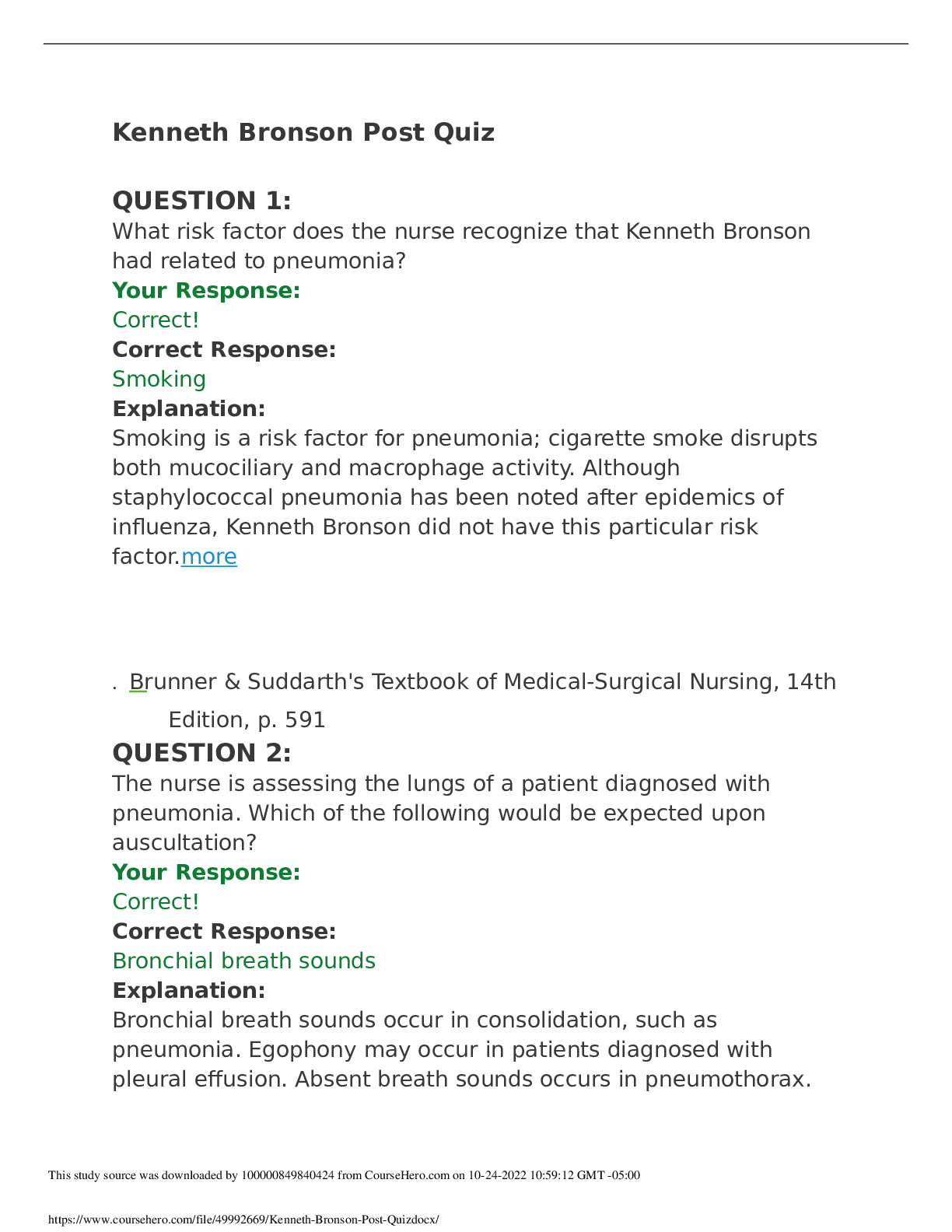



 Questions and Answers 100% VERIFIED.png)
 Questions and Answers 100% correct Solutions.png)



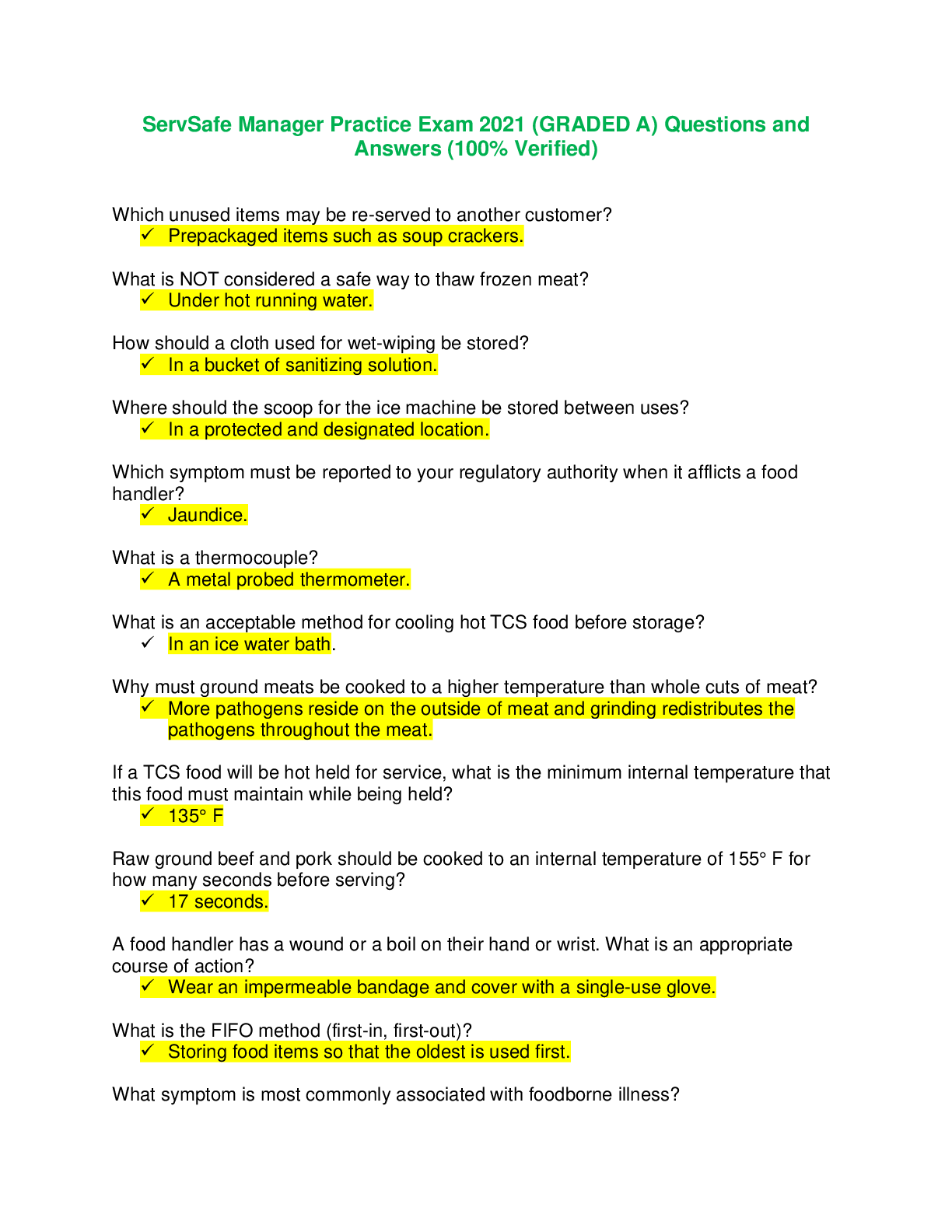




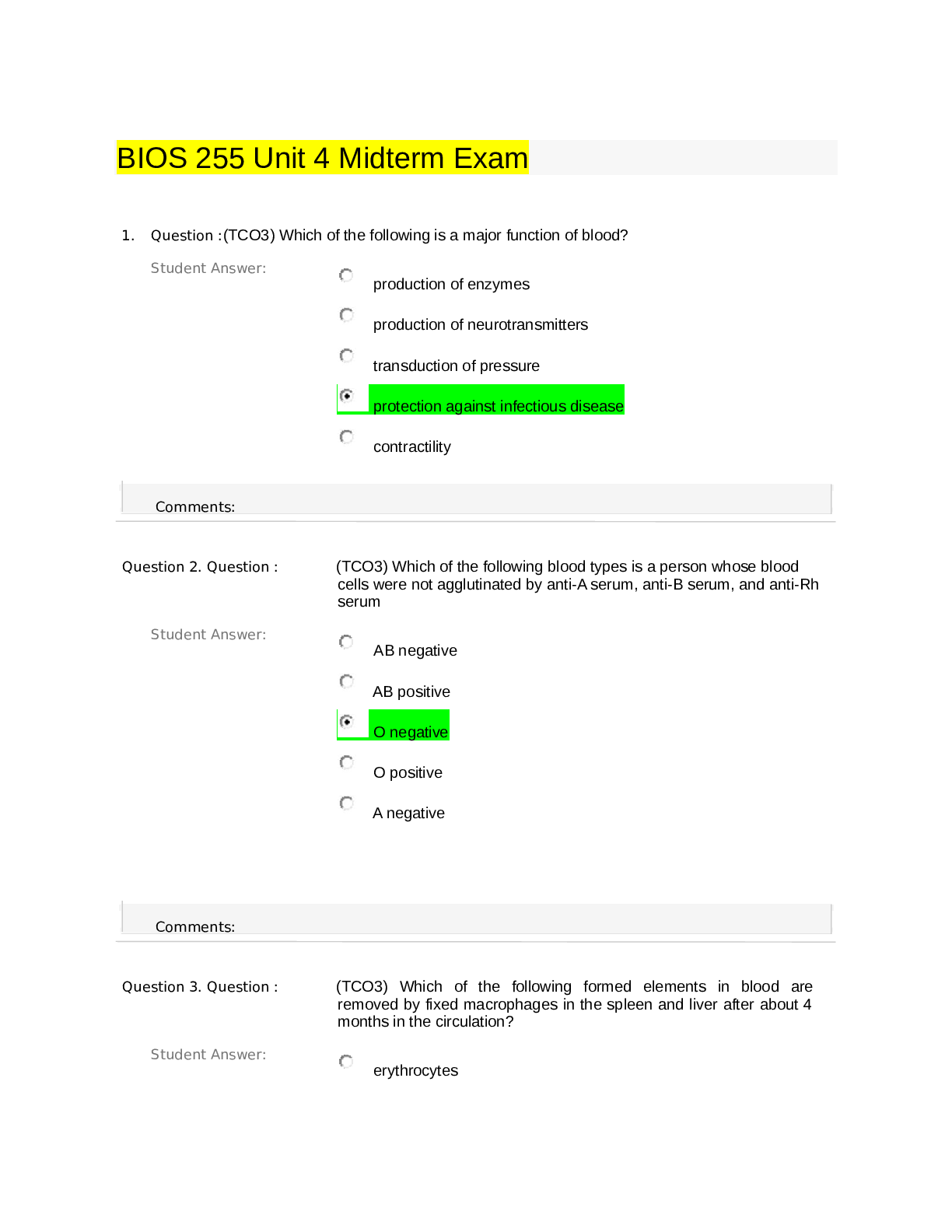
 Rasmussen MY21.png)

